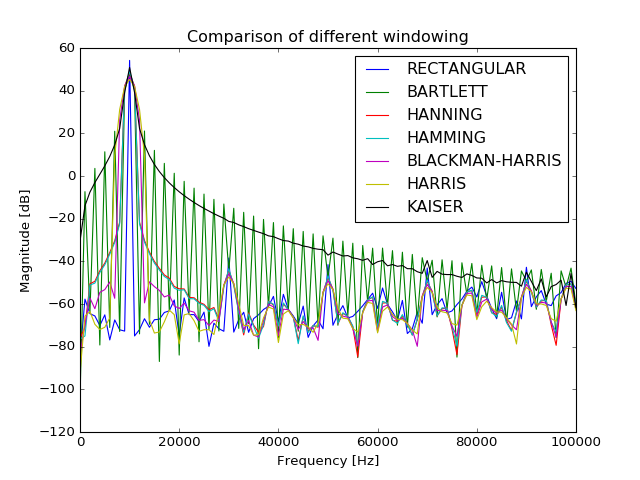ahkab.fourier¶
This module offers the functions needed to perform a Fourier analysis of the results of a simulation.
Module reference¶
-
fourier(label, tran_results, fund)[source]¶ Fourier analysis of the time evolution of a variable.
In particular, the function uses the first 10 multiples of the fundamental frequency and a rectangular window.
A variable amount of time data is used, resampled with a fixed time step. The length of the data is decided as follows:
- The data should be taken from the end of the simulation, so that if there is any build-up or stabilization process, the Fourier analysis is not affected (or less affected) by it.
- At least 1 period of the fundamental should be used.
- Not more than 50% of the total simulation time should be used, if possible.
- Respecting the above, as much data as possible should be used, as it leads to more accurate results.
Parameters:
- label : str or tuple of str
- The identifier of a variable. Eg.
'Vn1'or'I(VS)'. Ifris yourtran_solutionobject, callingr.keys()will give you all the possible variable names for your result set. If a tuple of two identifiers is provided, the difference of the two, in the formlabel[0]-label[1], will be used. - tran_results : tran_solution instance
- The TRAN results containing the time data for the
'label'variable. - fund : float
- The fundamental frequency, in Hertz.
Returns:
- f : ndarray of floats
- The frequencies correspoding to the
Farray below. - F : ndarray of complex data
- The result of the Fourier transform, including DC.
- THD : float
- The total harmonic distortion. This value, for a meaningful case, should be in the range (0, 1).
-
spicefft(label, tran_results, freq=None, **args)[source]¶ FFT analysis of the time evolution of a variable.
This function is a much more flexible and complete version of the
ahkab.fourier.fourier()function.The function uses a variable amount of time data, resampled with a fixed time step. The time interval is specified through the
startandstopparameters, if they are not set, all the available data is used.The function behaves differently whether the parameter
freqis specified or not:- If the fundamental frequency
freq(\(f\) in the following) is specified, the function will perform an harmonic analysis, considering only the DC component and the harmonics of \(f\) up to the 9th (ie \(f\), \(2f\), \(3f\) \(\dots\) \(9f\)). - If
freqis left unspecified, a standard FFT analysis is performed, starting from \(f = 0\), to a frequency \(f_{max} = 1/(2T_{TOT}n_p)\), where \(T_{TOT}\) is the total length of the considered data in seconds and \(n_p\) is the number of points in the FTT, set through thenpparameter to this function.
Parameters:
- label : str, or tuple of str
- The identifier of a variable. Eg.
'Vn1'or'I(VS)'. Ifris yourtran_solutionobject, callingr.keys()will give you all the possible variable names for your result set. If a tuple of two identifiers is provided, the difference of the two, in the formlabel[0]-label[1], will be used. - tran_results : tran_solution instance
- The TRAN results containing the time data for the
'label'variable. - freq : float, optional
- The fundamental frequency, in Hertz. If it is specified, the output will be limited to the harmonics of this frequency. The THD evaluation will also be enabled.
- start : float, optional
- The first time instant to be considered for the transient analysis. If unspecified, it will be the beginning of the transient simulation.
- from : float, optional
- Alternative specification of the
startparameter. - stop : float, optional
- Last time instant to be considered for the FFT analysis. If unspecified, it will be the end time of the transient simulation.
- to : float, optional
- Alternative specification of the
stopparameter. - np : integer
- A power of two that specifies how many points should be used when computing the FFT. If it is set to a value that is not a power of 2, it will be rounded up to the nearest power of 2. It defaults to 1024.
- window : str, optional
The windowing type. The following values are available:
- ‘RECT’ for a rectangular window, equivalent to no window at all.
- ‘BART’, for a Bartlett window.
- ‘HANN’, for a Hanning window.
- ‘HAMM’ for a Hamming window.
- ‘BLACK’ for a Blackman window.
- ‘HARRIS’ for a Blackman-Harris window.
- ‘GAUSS’ for a Gaussian window.
- ‘KAISER’ for a Kaiser-Bessel window.
The default is the rectangular window.
- alpha : float, optional
- The \(\sigma\) for a gaussian window or the \(beta\) for a Kaiser window. Defaults to 3 and is ignored if a window different from Gaussian or Kaiser is selected.
- fmin : float, optional
- Suppress all data below this frequency, expressed in Hz. The suppressed data is neither returned nor used to compute the THD (if it is computed at all). The DC component is always preserved. Defaults to: return and use all data.
- fmax : float, optional
- The dual to
fmin, discard data abovefmaxand also do not use it if computing the THD. Defaults to infinity.
Returns:
- f : ndarray of floats
- The frequencies, including the DC.
- F : ndarray of complex data
- The result of the Fourier transform, including DC.
- THD : float
- The total harmonic distortion, if
freqwas specified,Noneotherwise.
(Source code, png, hires.png, pdf)

- If the fundamental frequency
